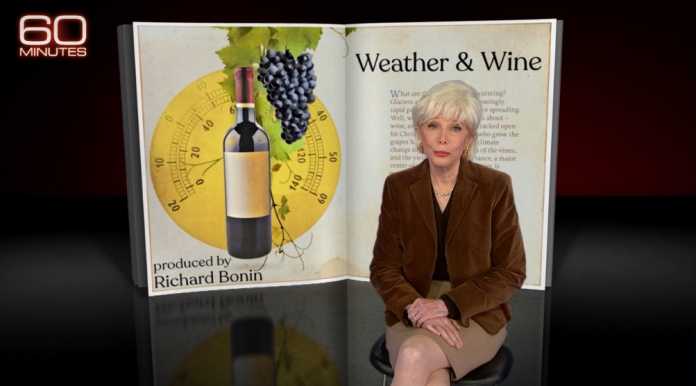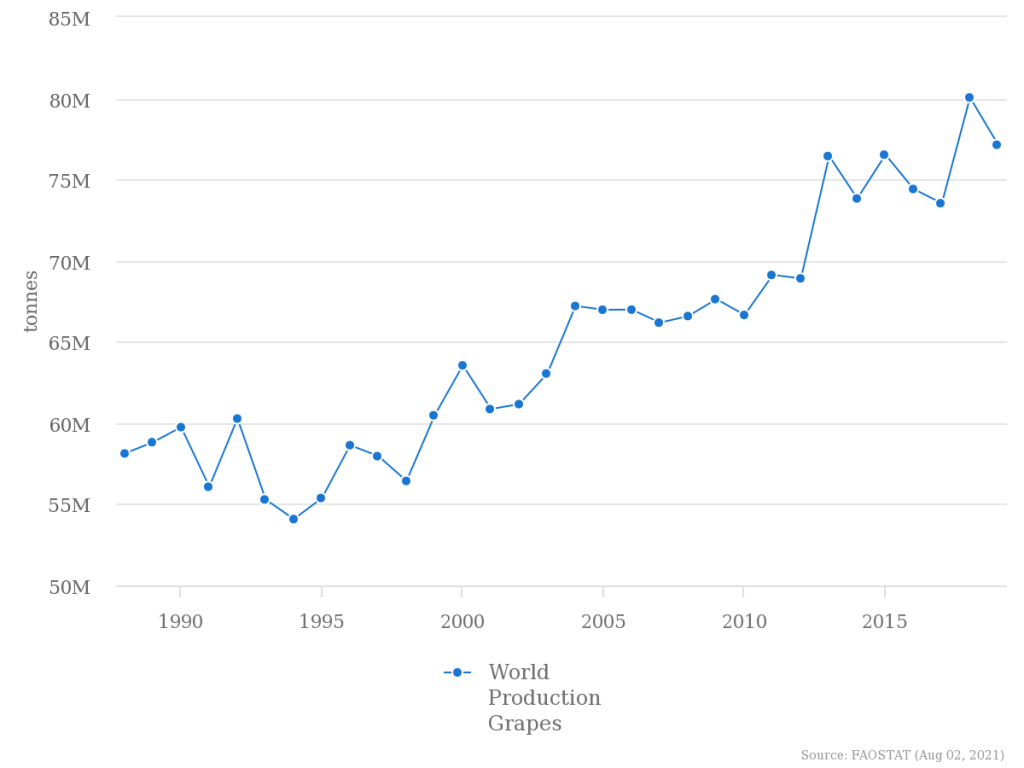In a segment in CBS’s long-running weekly news program, 60 Minutes, Leslie Stahl interviewed a few vintners in France who say climate change is destroying its wine and champagne industries. Data show otherwise. Although France suffered low production in 2021 due to a combination of drought and untimely cold weather, global grape production has done well, repeatedly setting records over the past three decades. Local weather conditions, not global climate change, now, as always, drive grape growing success.
In the news segment, titled “Effects of climate change taking root in the wine industry,” 60 Minutes opines:
What are the signs of global warming? Glaciers are melting at an increasingly rapid pace. Persistent droughts are spreading. Well, we have another to tell you about – wine, as in what you probably cracked open for Christmas dinner.
Farmers who grow the grapes have seen the effects of climate change in the soil, in the roots of the vines, and the yields of their crops.
2021 has been a particularly bad year for wine production in France and, to a lesser extent, globally. Stahl interviewed several long-time wine producers in France who linked the low wine production in 2021 to climate change. Data indicates 2021 is an anomaly, not indicative of a long-term trend which might implicate a changing climate. France and other top wine producing countries in the region experienced a particularly bad weather year.
“The almost catastrophic figures from France were caused by very unfavorable climatic [sic] conditions during most of the growing season: frost, hail, storms, and humidity in the summer (causing diseases),” writes Forbes magazine in an article discussing global wine producing hardships in 2021.
As Forbes detailed, although weather conditions in Europe were unfavorable to wine production in 2021, other countries were producing more wine than in the previous year:
The USA, the world’s third-biggest wine producer, increased the wine volume by 6 percent to reach 24.1 million hectoliters (Mhl). A “hectoliter” is a metric unit of volume equal to 100 liters. Australia, Chile, Argentina and South Africa, who usually jockey for positions five to eight in the world ranking, did well, or very well in some cases: up 30 percent for both Australia and Chile (to 14.2 Mhl and 13.4 Mhl respectively), +16 percent for Argentina (12.5 Mhl), and a more modest +2 pecent for South Africa (10.6 Mhl).
Grape production, as with all other crops, varies from year to year, due to a variety of factors, such as the local weather conditions, farm inputs, and acres planted. Despite the yearly ups and downs, the record clearly shows, as the earth has modestly warmed grape production has increased. As vintners in different countries have faced different challenges, they have adapted, planting the varietals that best suit their particular soils and weather conditions.
Indeed, data from the U.N. Food and Agriculture Organization (FAO), shows the five highest years of grape production on record have all occurred since 2013. (See the figure)
Contrary to the impression left by 60 Minutes’ story, during the recent period of modest warming, new records for global grape production were set in 2013, 2015, and most recently in 2018. Between 1988 and 2019—the last year for which FAO has data and also the second largest production year on record—grape production increased by approximately 33 percent.
Looking at individual wine producing countries, FAO data show that grape production has grown substantially in seven of the top 10 wine producing countries between 1988 and 2019.
Wine production does not directly track grape production. Demand, market prices, competing demands for grapes, and coordinated market strategies—which some might call collusion or an attempt to fix prices—can limit or contribute to an increase in wine production. For example, global wine production dramatically increased in 2018 in Europe and globally, it being the second highest production year since 2000. In response, the study “State of the World Vitivinicultural Sector In 2020,” found several “Italian, French and Spanish producers’ associations to fix the vinified volumes at a level lower to that of 2019 because of the expected drop in demand on the global wine market, the favorable weather led to a bountiful harvest in many regions of the EU.”
So, in 2020, wine producers in France, Italy, and Spain, were trying to suppress wine production to manipulate the market due the previous year’s high yields. This happened just a year before inclement weather conditions resulted in poor wine growing conditions. One year’s bad weather does not equal climate change induced problems for the wine industry.
Indeed, data show 2018 was the second highest year for wine production in the since 2000, and 2013 was the third highest production year.
As the CBC explained recently, weather and climate, although often confused or treated as interchangeable by corporate media outlet like CBS’s 60 Minutes, are two different things.
[T]he most common terms — like weather and climate — can be deceiving.
Those two terms are sometimes used interchangeably and while they are linked, they actually refer to different things.
With weather and climate, the biggest factor is time.
Weather refers to the short term.
…
Weather systems can also bring extremely unusual conditions to an area ….
…
[C]limate is defined by long-term averages.
Climate refers to the atmospheric trends for an area.
It takes a look at specific weather conditions for a certain region and averages them over a set period of time.
Climate change is accounted for by most government agencies involved with monitoring weather and climate as changes in average conditions over a thirty year period. In 2021 France experienced a bad spell of weather which affected grape production. There has been no significant change in average temperatures or precipitation in France or in most European wine producing countries over the past 30 years.
While the weather outside may have been frightful for wine producers in France in 2021, contrary to 60 Minutes’ story, data clearly show long-term climate change is not devastating wine production there or anywhere else.





















